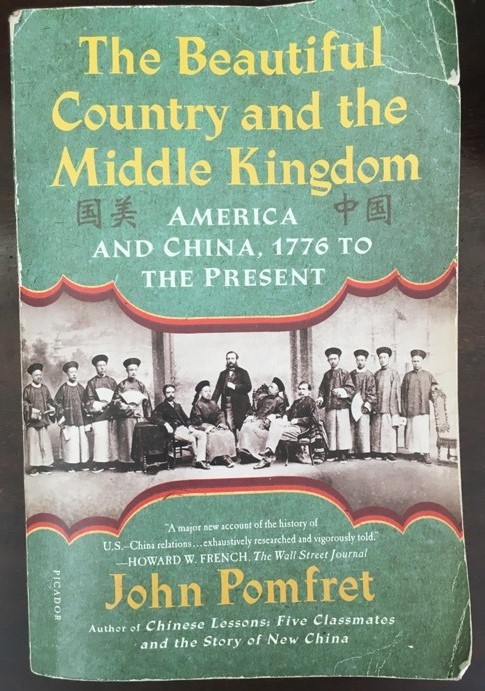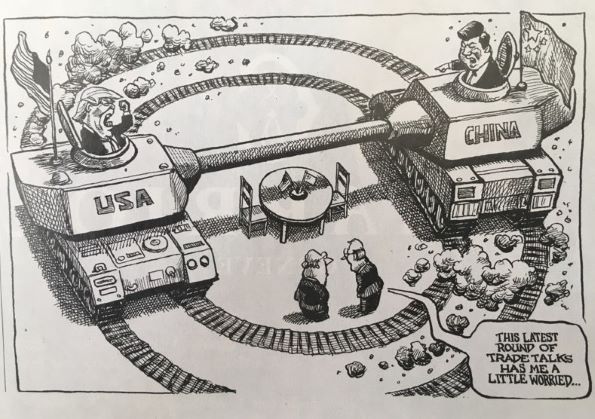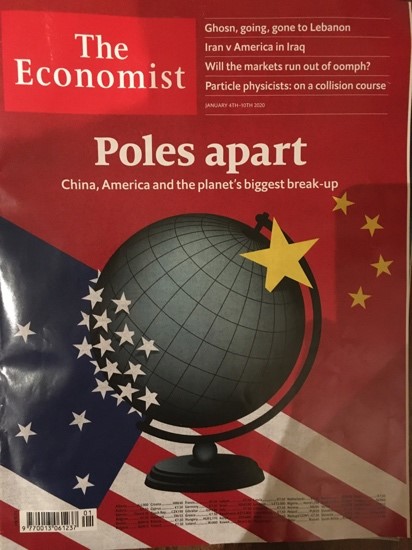
The Beautiful Country and the Middle Kingdom: America and China, 1776 to the Present by JohnPomfret. Published by Henry Holt and Company, 2016, 704 pages. ISBN-10: 0805092501, ISBN-13: 978-0805092509. Hardcover, Kindle, and audio versions available on Amazon.
The rather battered and dog-eared cover to my copy of The Beautiful Country and the Middle Kingdom. America and China, 1776 to the Present by John Pomfret is testimony to both prolonged and careful reading. The fact that this historical account of the relationship between these two nations is dense with fascinating information spanning diverse topics over more than two centuries accounts for both.
When I started reading the book last year, it seemed very relevant given the shift taking place in the relationship—as Pomfret shows has happened numerous times. I half-expected there to be a swing back again before I’d finished but instead it seems Sino-US relations have entered rougher times as captured in journals and cartoons (see below)—and this before COVID-19.


Pomfret’s short chapter headings encapsulate some of these changes: Blitzconversion (chapter 3), Hot Air and Hope (chapter 9), Up in Smoke (chapter 13), Opportunity or Threat (chapter 15), Dangerous Liaisons (chapter 21), Mission Impossible (chapter 26), Hate America (chapter 28), Hate China (chapter 29), Tacit Allies (chapter 36), China Rediscovers America (chapter 38), From China with Love (chapter 43).
A cursory glance reveals cycles of enchantment turning to disillusion and despair then back, interest to paranoia then back, beguiled to belligerent, bluster to insecurity, co-operation to competition, friend to foe. Each time, there appears to be the underlying concern of who has leverage over whom and how that can be maintained and enhanced. Not surprisingly, as Pomfret tries to find patterns in the “baffling complexities” (page 6) which is what historians seek to do, he finds many echoes of the past in the present and a reiteration of themes.
One such theme is the way in which America has sought to “bend the arc of China’s history” (page 572). In order to change China, America introduced, promoted, and invested in feminist ideology; the rule of law; car culture (Ford in the 1930s, General Motors in 1990s); the aviation industry (pilot training in the 1920s, creating an aviation industry in the 1990s); recreation particularly basketball; education with its stress on independence, creative thinking, asking questions, and the belief that everyone can succeed; parenting styles. Each of these is traced over the years with biographical accounts, anecdotes, and differing opinions about how to read events. Beneath it all was the hope for a democratic China and the undeniable, irresistible lure of the huge Chinese market. For this, China needed to remain whole for stability and be transformed into an “Asian America” (page 569).
Another theme, potentially at odds with America’s, is the consistent desire of China to equal (and then surpass) America as a nation on the world stage—heard in world conferences, accepted in the World Trade Organization, included in hosting global events. Here was the rub between learning from America, depending on US consumers buying affordable (cheap) Chinese goods, and becoming independent and not sold-out to America’s democratic ideology or enmeshed in what was seen as American imperialism. Pomfret notes both the Chinese Communist Party’s dreams and fears as well as those of the ordinary people who wanted the benefits that were part of the American Dream. He recounts how various people were used or chose to engage in making this happen, courting individuals, companies, and organizations. As recently as 2018, the Communist Party was adamant to claim and dress it as the Chinese Dream.
In the case of both nations, there was the push-pull of admiration for things American or Chinese and then the suspicion and mistrust of the other often around issues of espionage or trade. We are seeing this currently. Each has anticipated the collapse of the other’s system due to its flawed ideology and cracking economy even as the co-dependency has continued and each has tried to “manage” the other (page 636). Leadership on both sides have benefitted from painting the other in threatening terms, even as at other times they have been anxious to show amicability.
Pomfret undoubtedly has respect for China and offers praise. It is born no doubt in large part from his experiences living there over the years as a student and then a correspondent. He continues to aspire to the notion of “Great Harmony” whereby the two nations can bring out the very best in the other but with more realism than inflated expectation.
While China, elephant-like, never forgets, American politicians and business people would be well-advised to trawl through this book to identify the recurring patterns and the pendulum swings in policy and popular feelings for, as Pomfret observes in his afterword, “the patterns of the past permeate the present” (page 653). They are overlooked or underestimated at the peril of those who hold a more foreshortened view.
Image credit: mohamed Hassan from Pixabay.

Andrea Klopper
Andrea Klopper has taught in South Africa, the United Kingdom, and China. She has mentored Mandarin language students and developed a cultural orientation and acquisition program which she used in two organizations. She is now being challenged to make friends in a new location and learning a new language. She …View Full Bio
Are you enjoying a cup of good coffee or fragrant tea while reading the latest ChinaSource post? Consider donating the cost of that “cuppa” to support our content so we can continue to serve you with the latest on Christianity in China.